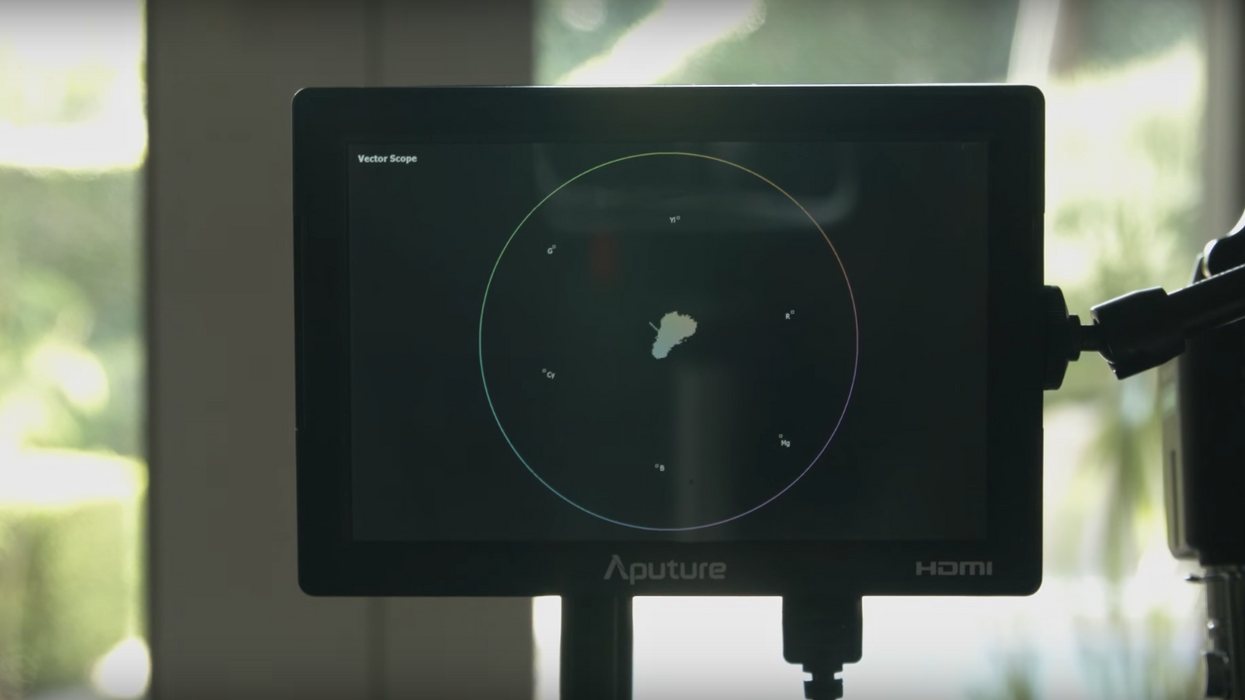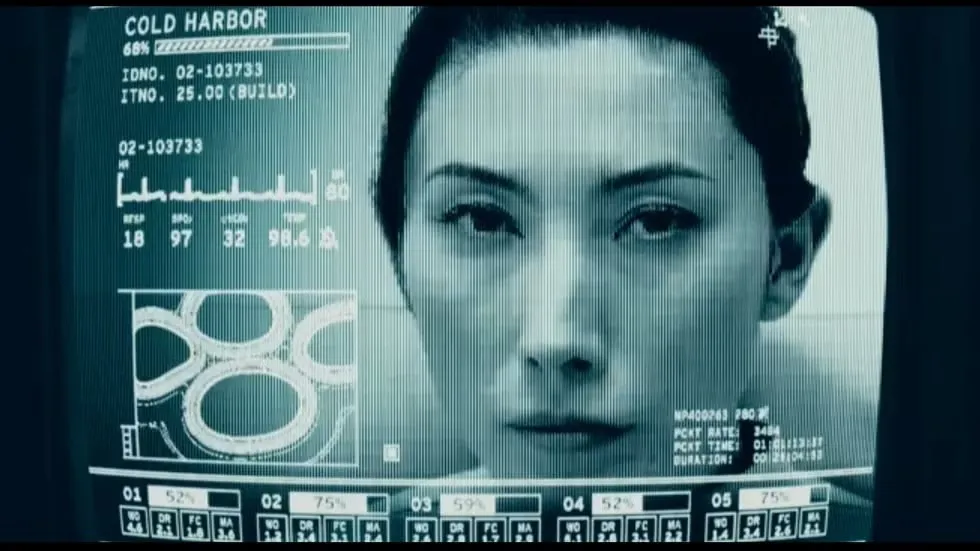The True Meaning Behind Cold Harbor

Severance
via Apple TV+
The ominous account looming over Lumon all season finally has some clarity—and its dastardly, absurd explanation has Lumon's corporate branding all over it.
As seen glimpsed in "Chikhai Bardo," the accounts that Mark S. has been refining are all associated with a room the imprisoned Gemma (Dichen Lachman) is going into and being severed for different experiences. These rooms involve many different environments, spanning from the dentist to a bizarre Christmas. Harmony Kobel clarifies that these rooms are indeed "Gemma's mind" that Mark is refining, and once he finishes the last account—Cold Harbor—Gemma is as good as gone.
With the rampant unpredictability at the heart of Severance, there's no telling what we were to expect beyond Cold Harbor's sleek white door—an actual harbor? Perhaps something linked to Woe's Hollow? More goats? It could have been anything, but the ultimate reveal was simply a wooden crib that Gemma was instructed to deconstruct. Once more, Lumon proves to be sinister in the most mundane and innocuous ways.
So what was the overarching importance of Cold Harbor and Mark's importance to completing it? That is still left relatively vague. We know that it is very important to the future of Lumon and their grander goals as a company, considering the weight placed on it and the literal mural of Mark S. completing it when he entered the severed floor, portraying him as a Lumon Messiah (not to mention his reward for completion, which included a standup routine between Mr. Milcheck and a wax Kier Eagan, as well as a marching band performance from the Choreography and Merriment department, respectively).
In the end, Cold Harbor was simply a big step for Lumon towards something bigger. What that is? We aren't so sure, but based on the context of Gemma's experimentation—imprisoned and experimented on as 25 different variants of innies—the answer is sure to incite the core temper of dread.
Macrodata Refinement Department Standings

Severance
via Apple TV+
Our fave four of the MDR crew went through a lot this season—innies and outies alike. Let's see where they left off by the end of "Cold Harbor."
Dylan G. (Zach Cherry)
- Innie: After filing to resign at the end of the penultimate "The After Hours," Dylan G. finds himself returning to the severed floor, surprised by his outies decision to move forward with Lumon. Mr. Milchick leaves him a sweet note explaining his choice and inspiring Dylan G with self-worth, leaving him to lead an army of Choreography and Merriment department in one last stand.
- Outie: Last we saw outie Dylan he was heartbroken that his wife Gretchen kissed his innie, threatening to quiet Lumon altogether. Based on his note he's in a better place, and we're looking forward to his growth next season.
Irving B. (John Turturro)
- Innie: Formally fired for the foreseeable future after exposing Helena Eagan at Woe's Hollow.
- Outie: We didn't see Irving in the outside world in "Cold Harbor". The last time we saw him, Burt dropped him off at a train station with a one-way ticket out of Kier for his safety. Considering Irving's mysterious phone calls and unconscious attachment to the dark hallway, we expect to see our boy Irv back at some point.
Helly R. (Britt Lower)
- Innie: Helly R. is a certified badass. Ever defiant and punk as heck, Helly risks everything to help Mark save Gemma, willing to be permanently erased in the process. "Cold Harbor" makes things particularly interesting with Jame Eagan's apparent interest in her and Mark S.'s choice to stay on the severed floor and be with her.
- Outie: After her covert innie operation was abruptly ended by Irving, we haven't heard much from Helena Eagan. What we do know? She's in a weird place with dad and has some very interesting feelings for Mark.
Mark S. (Adam Scott)
See below...
Outie Mark and Innie Mark Aren't Cool

Severance
via Apple TV+
Oh, Mark Scout and Mark S. (outie Mark and innie Mark, cleverly abbreviated to oMark and iMark by the AV Club, so let's steal that)? They aren't talking right now.
To be fair, they weren't talking before outside of some coded back and forths from the severed floor. That was until they had their first semi-real-time conversation at the Lumon Severed Birthing Retreat cabin introduced last season, allowing them to record video messages and have a back-and-forth walking inside and outside the cabin.
This nearly 10-minute scene was a ton of fun to watch, if stressfully revelatory in creating a division between iMark and oMark's intentions and livelihoods. The emotional throughline of Severance has followed oMark's grief over the loss of Gemma, and learning she's alive and imprisoned in Lumon gave him a new lease on life to save her. In a heartbreaking moment, he even reconciles with the fact that he's entered the bargaining stage of the grief cycle "only this time he might actually have a chance".
On the other hand, iMark—clearly a well-intentioned guy—is concerned for his own wellbeing (i.e., his existence), and is lovesick for Helly R. If he saves Gemma and pulls the veil off of Lumon, not only will they cease to exist, but he'll never get to fulfill his desires and see out his affair with Helly. This is further complicated by the fact that Helly's outie is Helena Eagan: the enemy.
So how do iMark and oMark resolve this complex conflict of interest? Well, it gets messy, folks. iMark stays true to his morals and follows through with the plan to save Gemma, barely making it to the hidden floor after sneaking away from an extravagant marching band number and a brutal fight with Mr. Drummond. Once oMark and Gemma return to the severed floor, changing back to iMark and Ms. Casey, iMark takes Ms. Casey to the severed stairwell, leaving her to escape. iMark, however? Chooses to stay behind with Helly R. in Lumon.
Pretty crazy! As frustrating and divisive as this choice was, it all makes perfect sense. As iMark declares with Helly R. earlier when making his choice, she comforts him that he'll get to live no matter what if oMark stays true to his word, even though she likely won't. His reply?
"But I want to live with you."
Oof.
Jame Eagan Has Plans for Helly R.

Severance
via Apple TV+
Jame Eagan is a bit of a creep, eh? I mean, everything we've come to know about the Eagan's expansive history is dripping with creep, so it's only fair our oldest living surrogate of the Eagan family carries this aura with him. We've only gotten snippets of his character here and there, but in "Cold Harbor" we get the most dastardly insight into his psyche yet.
Visiting the severed floor, Jame Eagan reveals two ominous and weird things. One, he has many "different seeds" (or whatever weird phrasing he chose), and Helena isn't even his favorite. Two, he "used to see the fire of Kier" in Helena, but no longer does. Who does he see it in now? Why, our very own innie, Helly R.! After a villainous monologue about his plans for her, he exits into the shadows, leaving us and Helly with a properly earned "what the fuck?"
Could Jame Eagan's attachment to Helly R. be what ultimately saves her and Mark S. next season? How does he plan to use an innie—an entity he's so gruesomely dehumanized to date—to groom? We'll have to see next season, folks.
We Get Some Answers About Those Mammalians Nurturables Goats

Severance
via Apple TV+
One of the larger outstanding mysteries Severance has left us to wonder about is—what the heck is up with those goats? We're shortly introduced to them in Season 1 when Mark and Helly discover a room with a flustered man feeding them milk and declaring, "They aren't ready." Season 2 expands on this, introducing us to the Mammalians Nurturables department—a grassy room full of goats and innies that have a savage nature to them, led by Gwendolyn Christie's Lorne.
The Season 2 reveal ultimately left us with more questions than answers. Is Lumon cloning goats? Are they transferring human consciousness into them? Are they growing workers out of animals? Knowing Lumon and how weird they are, their answer could have amounted to just about anything. The reveal is much more grounded than expected (at least for me), but also equally weird in-and-of itself.
It turns out the kids (baby goats!) are being raised with the sole intent to be sacrificed as a ritualistic spirit guide to Lumon's prisoners once they're done with them and plan to execute, obviously. This sacrificial scene was thankfully interrupted by Mark attempting to break into the black hallway, saving the poor baby goat and ultimately leading to a brutal fight scene with Mr. Drummond, leading to his accidental death.
Is there more to Mammalian Nurturables than what's revealed in "Cold Harbor"? Honestly, very likely! Regardless of how you felt about this reveal and the future of MN, you have to give it to Severance for committing to a corporate department dedicated to raising little baby goats.
Gemma's Rescue Could "Kill Them All"

Severance
via Apple TV+
As Mark and Gemma are escaping from Gemma's Lumon-polished prison, her captor, Dr. Mauer (Robby Benson), yells out, "You'll kill them all!" as the elevator doors close behind them. Dr. Mauer doesn't have the best track record as far as manipulation goes, but if Harmony Kobel's word is to be taken at face value if Gemma goes public with her experience as a captor at Lumon, that could mean the end for all innies.
Is this what Dr. Mauer is referring to in his desperate declaration? Or is there a deeper meaning? It begs the question simply due to the blinking red alarm system going off in the severed floor, an ominous note to end on, and a larger question to the fate of the innies if Lumon were to be defeated.
Mysterious and Important Loose Ends

Severance
via Apple TV+
As satisfying as "Cold Harbor" is on narrative grounds, it still leaves us with many outstanding mysteries, large and small. Let's leave them all out to dry—and feel free to remind us of any others lingering in the comments.
Severance Season 2 Loose Ends
- Where the heck is Ricken? We last saw him in a disagreement with Devon about the integrity of his "innie-centric" approach to The You You Are.
- Where do Harmony and Milchick's loyalties ultimately lie? Judging by "Cold Harbor" Harmony is full anti-Lumon, while Milchick remains Lumon loyal, if not outwardly frustrated with them. Curious to see how their arcs play out.
- What is Lumon's grand scheme? We know all too well how important Mark S.'s completion of Cold Harbor is to the future of Lumon, but what the grander plan is is still mysterious (and likely important).
- How will Mark's reintegration play into next season? Although incomplete, he was starting to feel the effects (and side effects) of merging his innie and outies consciousness. Now that he's chosen to stay on the severed floor with Helly R., how will severed personalities conflict?
- Who has Irving been communicating to and what is Burt's relationship with Lumon?
- Can a performance from Choreography and Merriment possibly be topped as a performance award?
All these questions and more will hopefully be answered when Severance returns (sooner than three years!)



















